Macroeconomic Policies, Recession, CRAs and Equilibrium Analysis
VerifiedAdded on 2020/04/13
|8
|1024
|101
Report
AI Summary
This report provides a comprehensive analysis of macroeconomic policies, specifically focusing on how fiscal and monetary measures can be utilized to restore economic equilibrium during recessions. It begins by examining the U.S. recession of 2001, detailing the implementation of monetary and fiscal policies and their impact on GDP, unemployment, and inflation. The report then shifts its focus to the U.K., analyzing the Bank of England's monetary policy and the government's fiscal measures during the 2009 recession, addressing the challenges posed by the liquidity trap and the inflation target. The report also delves into the role of Credit Rating Agencies (CRAs) in determining risk premium, based on an empirical study assessing the impact of various risks on CRA performance. Finally, the report concludes by summarizing the effectiveness of macroeconomic policies in achieving economic stability and growth.
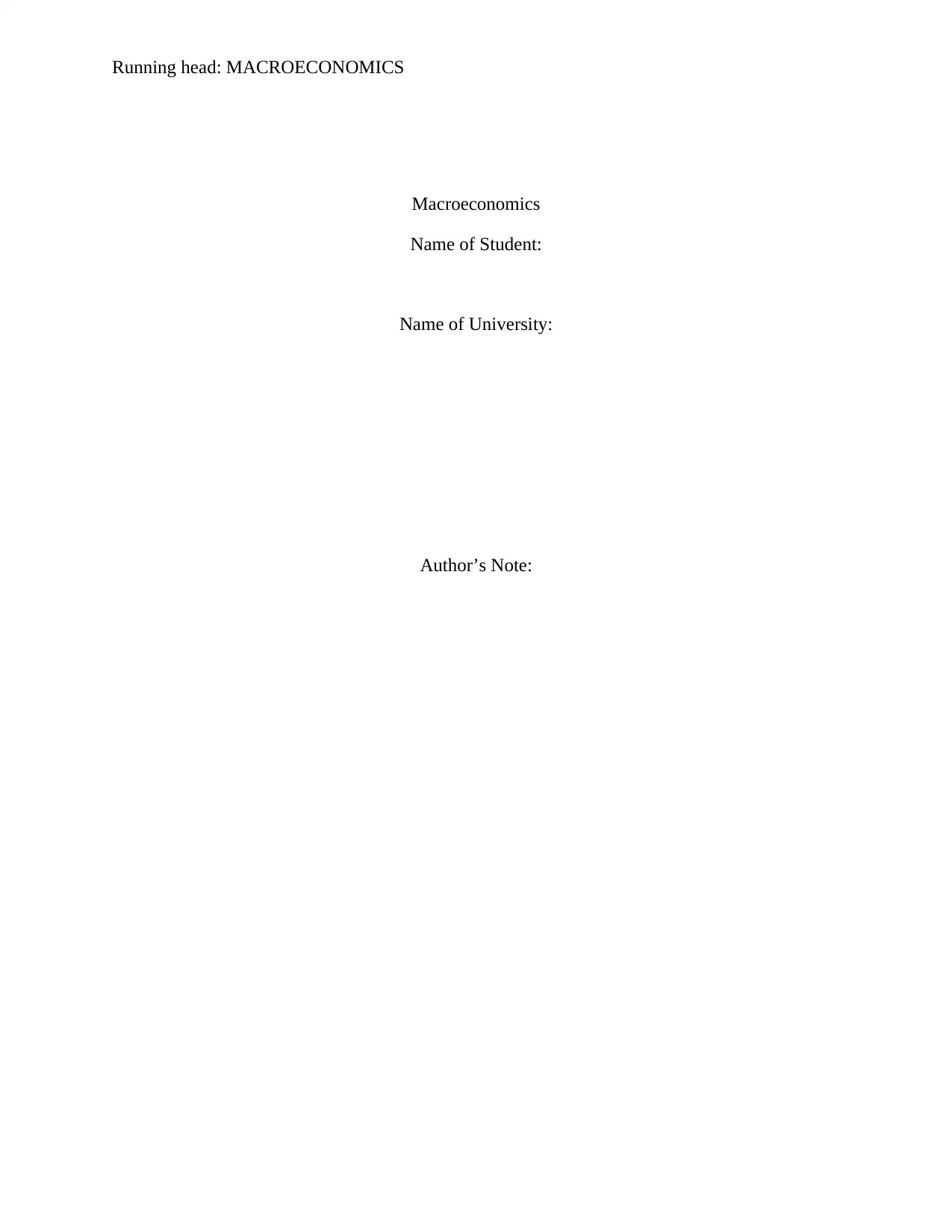
Running head: MACROECONOMICS
Macroeconomics
Name of Student:
Name of University:
Author’s Note:
Macroeconomics
Name of Student:
Name of University:
Author’s Note:
Paraphrase This Document
Need a fresh take? Get an instant paraphrase of this document with our AI Paraphraser
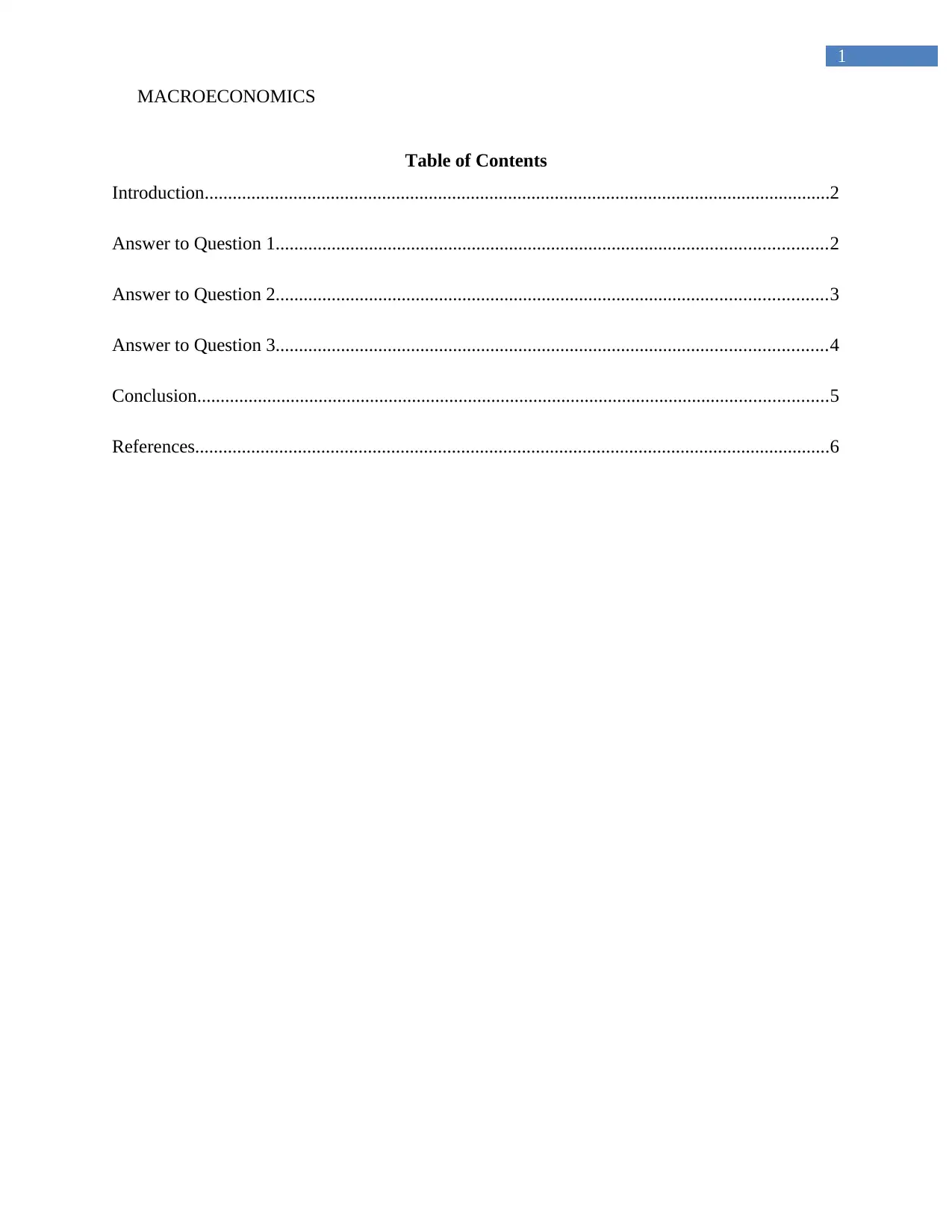
1
MACROECONOMICS
Table of Contents
Introduction......................................................................................................................................2
Answer to Question 1......................................................................................................................2
Answer to Question 2......................................................................................................................3
Answer to Question 3......................................................................................................................4
Conclusion.......................................................................................................................................5
References........................................................................................................................................6
MACROECONOMICS
Table of Contents
Introduction......................................................................................................................................2
Answer to Question 1......................................................................................................................2
Answer to Question 2......................................................................................................................3
Answer to Question 3......................................................................................................................4
Conclusion.......................................................................................................................................5
References........................................................................................................................................6
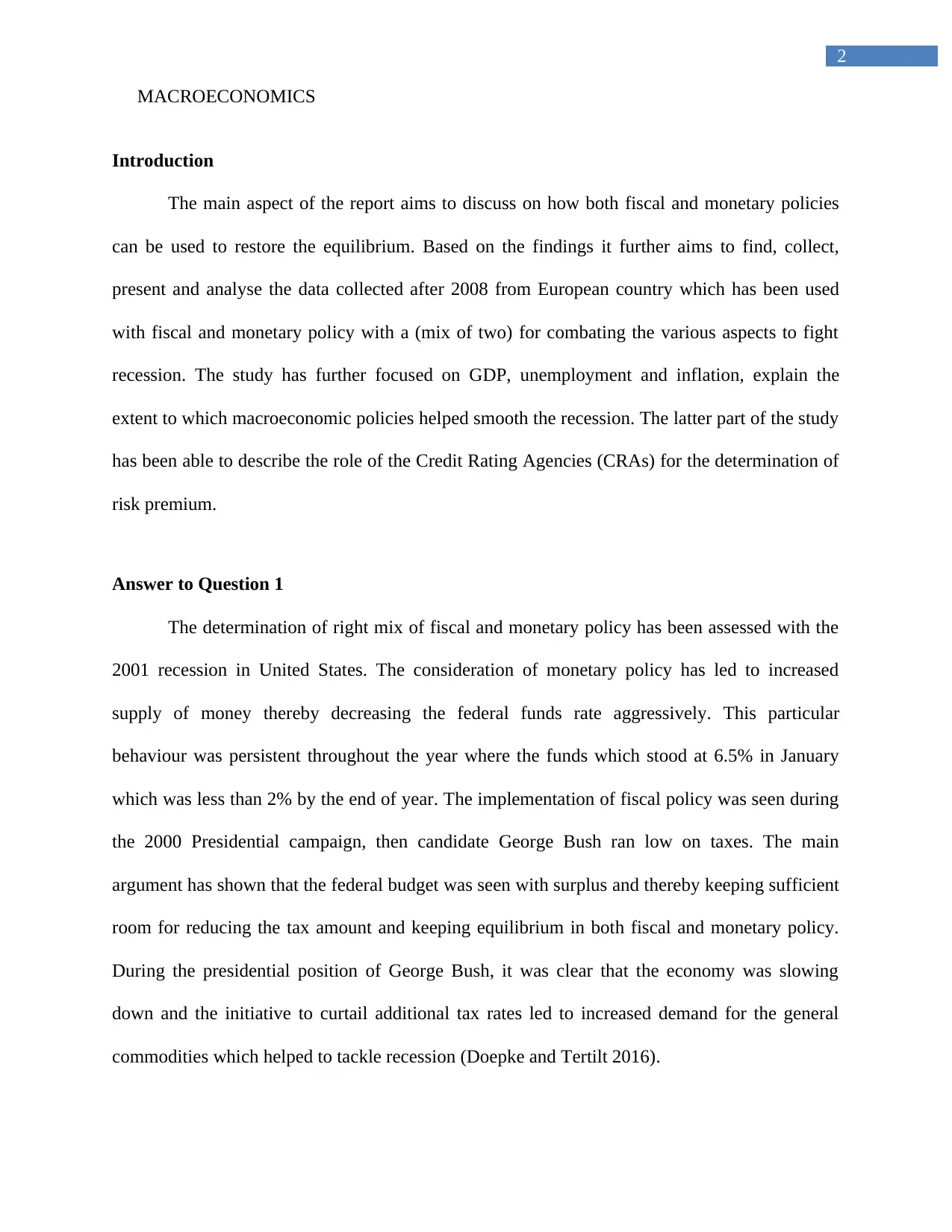
2
MACROECONOMICS
Introduction
The main aspect of the report aims to discuss on how both fiscal and monetary policies
can be used to restore the equilibrium. Based on the findings it further aims to find, collect,
present and analyse the data collected after 2008 from European country which has been used
with fiscal and monetary policy with a (mix of two) for combating the various aspects to fight
recession. The study has further focused on GDP, unemployment and inflation, explain the
extent to which macroeconomic policies helped smooth the recession. The latter part of the study
has been able to describe the role of the Credit Rating Agencies (CRAs) for the determination of
risk premium.
Answer to Question 1
The determination of right mix of fiscal and monetary policy has been assessed with the
2001 recession in United States. The consideration of monetary policy has led to increased
supply of money thereby decreasing the federal funds rate aggressively. This particular
behaviour was persistent throughout the year where the funds which stood at 6.5% in January
which was less than 2% by the end of year. The implementation of fiscal policy was seen during
the 2000 Presidential campaign, then candidate George Bush ran low on taxes. The main
argument has shown that the federal budget was seen with surplus and thereby keeping sufficient
room for reducing the tax amount and keeping equilibrium in both fiscal and monetary policy.
During the presidential position of George Bush, it was clear that the economy was slowing
down and the initiative to curtail additional tax rates led to increased demand for the general
commodities which helped to tackle recession (Doepke and Tertilt 2016).
MACROECONOMICS
Introduction
The main aspect of the report aims to discuss on how both fiscal and monetary policies
can be used to restore the equilibrium. Based on the findings it further aims to find, collect,
present and analyse the data collected after 2008 from European country which has been used
with fiscal and monetary policy with a (mix of two) for combating the various aspects to fight
recession. The study has further focused on GDP, unemployment and inflation, explain the
extent to which macroeconomic policies helped smooth the recession. The latter part of the study
has been able to describe the role of the Credit Rating Agencies (CRAs) for the determination of
risk premium.
Answer to Question 1
The determination of right mix of fiscal and monetary policy has been assessed with the
2001 recession in United States. The consideration of monetary policy has led to increased
supply of money thereby decreasing the federal funds rate aggressively. This particular
behaviour was persistent throughout the year where the funds which stood at 6.5% in January
which was less than 2% by the end of year. The implementation of fiscal policy was seen during
the 2000 Presidential campaign, then candidate George Bush ran low on taxes. The main
argument has shown that the federal budget was seen with surplus and thereby keeping sufficient
room for reducing the tax amount and keeping equilibrium in both fiscal and monetary policy.
During the presidential position of George Bush, it was clear that the economy was slowing
down and the initiative to curtail additional tax rates led to increased demand for the general
commodities which helped to tackle recession (Doepke and Tertilt 2016).
⊘ This is a preview!⊘
Do you want full access?
Subscribe today to unlock all pages.

Trusted by 1+ million students worldwide
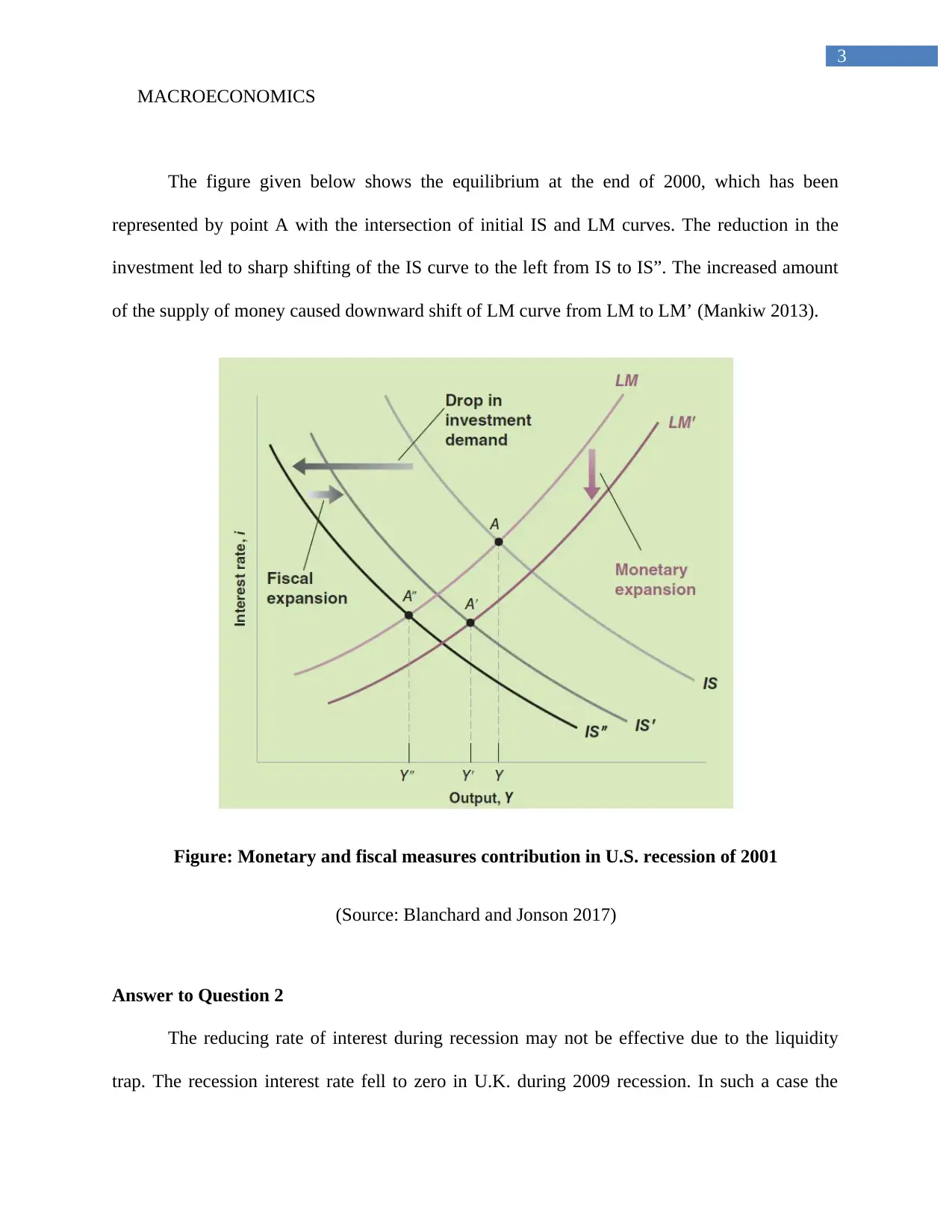
3
MACROECONOMICS
The figure given below shows the equilibrium at the end of 2000, which has been
represented by point A with the intersection of initial IS and LM curves. The reduction in the
investment led to sharp shifting of the IS curve to the left from IS to IS”. The increased amount
of the supply of money caused downward shift of LM curve from LM to LM’ (Mankiw 2013).
Figure: Monetary and fiscal measures contribution in U.S. recession of 2001
(Source: Blanchard and Jonson 2017)
Answer to Question 2
The reducing rate of interest during recession may not be effective due to the liquidity
trap. The recession interest rate fell to zero in U.K. during 2009 recession. In such a case the
MACROECONOMICS
The figure given below shows the equilibrium at the end of 2000, which has been
represented by point A with the intersection of initial IS and LM curves. The reduction in the
investment led to sharp shifting of the IS curve to the left from IS to IS”. The increased amount
of the supply of money caused downward shift of LM curve from LM to LM’ (Mankiw 2013).
Figure: Monetary and fiscal measures contribution in U.S. recession of 2001
(Source: Blanchard and Jonson 2017)
Answer to Question 2
The reducing rate of interest during recession may not be effective due to the liquidity
trap. The recession interest rate fell to zero in U.K. during 2009 recession. In such a case the
Paraphrase This Document
Need a fresh take? Get an instant paraphrase of this document with our AI Paraphraser
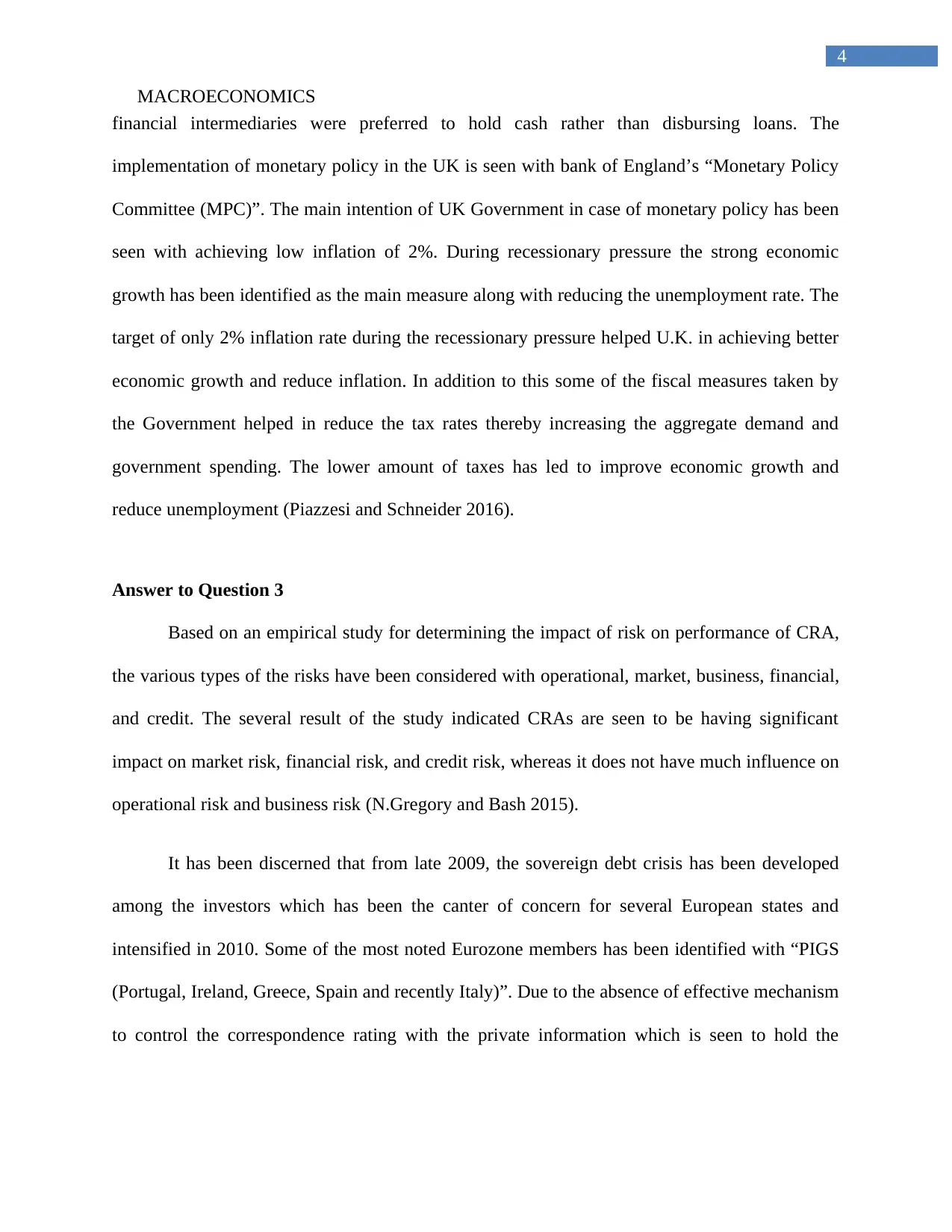
4
MACROECONOMICS
financial intermediaries were preferred to hold cash rather than disbursing loans. The
implementation of monetary policy in the UK is seen with bank of England’s “Monetary Policy
Committee (MPC)”. The main intention of UK Government in case of monetary policy has been
seen with achieving low inflation of 2%. During recessionary pressure the strong economic
growth has been identified as the main measure along with reducing the unemployment rate. The
target of only 2% inflation rate during the recessionary pressure helped U.K. in achieving better
economic growth and reduce inflation. In addition to this some of the fiscal measures taken by
the Government helped in reduce the tax rates thereby increasing the aggregate demand and
government spending. The lower amount of taxes has led to improve economic growth and
reduce unemployment (Piazzesi and Schneider 2016).
Answer to Question 3
Based on an empirical study for determining the impact of risk on performance of CRA,
the various types of the risks have been considered with operational, market, business, financial,
and credit. The several result of the study indicated CRAs are seen to be having significant
impact on market risk, financial risk, and credit risk, whereas it does not have much influence on
operational risk and business risk (N.Gregory and Bash 2015).
It has been discerned that from late 2009, the sovereign debt crisis has been developed
among the investors which has been the canter of concern for several European states and
intensified in 2010. Some of the most noted Eurozone members has been identified with “PIGS
(Portugal, Ireland, Greece, Spain and recently Italy)”. Due to the absence of effective mechanism
to control the correspondence rating with the private information which is seen to hold the
MACROECONOMICS
financial intermediaries were preferred to hold cash rather than disbursing loans. The
implementation of monetary policy in the UK is seen with bank of England’s “Monetary Policy
Committee (MPC)”. The main intention of UK Government in case of monetary policy has been
seen with achieving low inflation of 2%. During recessionary pressure the strong economic
growth has been identified as the main measure along with reducing the unemployment rate. The
target of only 2% inflation rate during the recessionary pressure helped U.K. in achieving better
economic growth and reduce inflation. In addition to this some of the fiscal measures taken by
the Government helped in reduce the tax rates thereby increasing the aggregate demand and
government spending. The lower amount of taxes has led to improve economic growth and
reduce unemployment (Piazzesi and Schneider 2016).
Answer to Question 3
Based on an empirical study for determining the impact of risk on performance of CRA,
the various types of the risks have been considered with operational, market, business, financial,
and credit. The several result of the study indicated CRAs are seen to be having significant
impact on market risk, financial risk, and credit risk, whereas it does not have much influence on
operational risk and business risk (N.Gregory and Bash 2015).
It has been discerned that from late 2009, the sovereign debt crisis has been developed
among the investors which has been the canter of concern for several European states and
intensified in 2010. Some of the most noted Eurozone members has been identified with “PIGS
(Portugal, Ireland, Greece, Spain and recently Italy)”. Due to the absence of effective mechanism
to control the correspondence rating with the private information which is seen to hold the
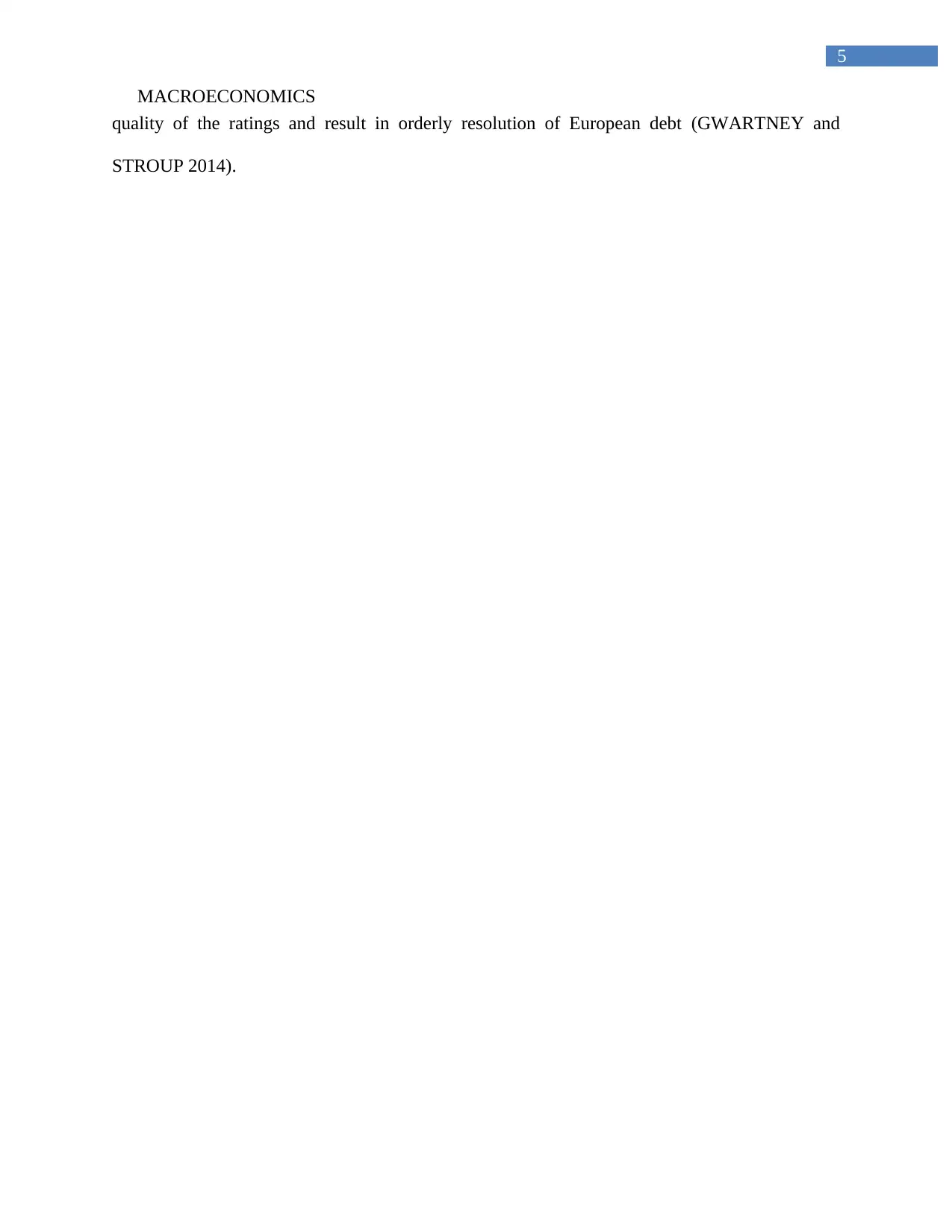
5
MACROECONOMICS
quality of the ratings and result in orderly resolution of European debt (GWARTNEY and
STROUP 2014).
MACROECONOMICS
quality of the ratings and result in orderly resolution of European debt (GWARTNEY and
STROUP 2014).
⊘ This is a preview!⊘
Do you want full access?
Subscribe today to unlock all pages.

Trusted by 1+ million students worldwide
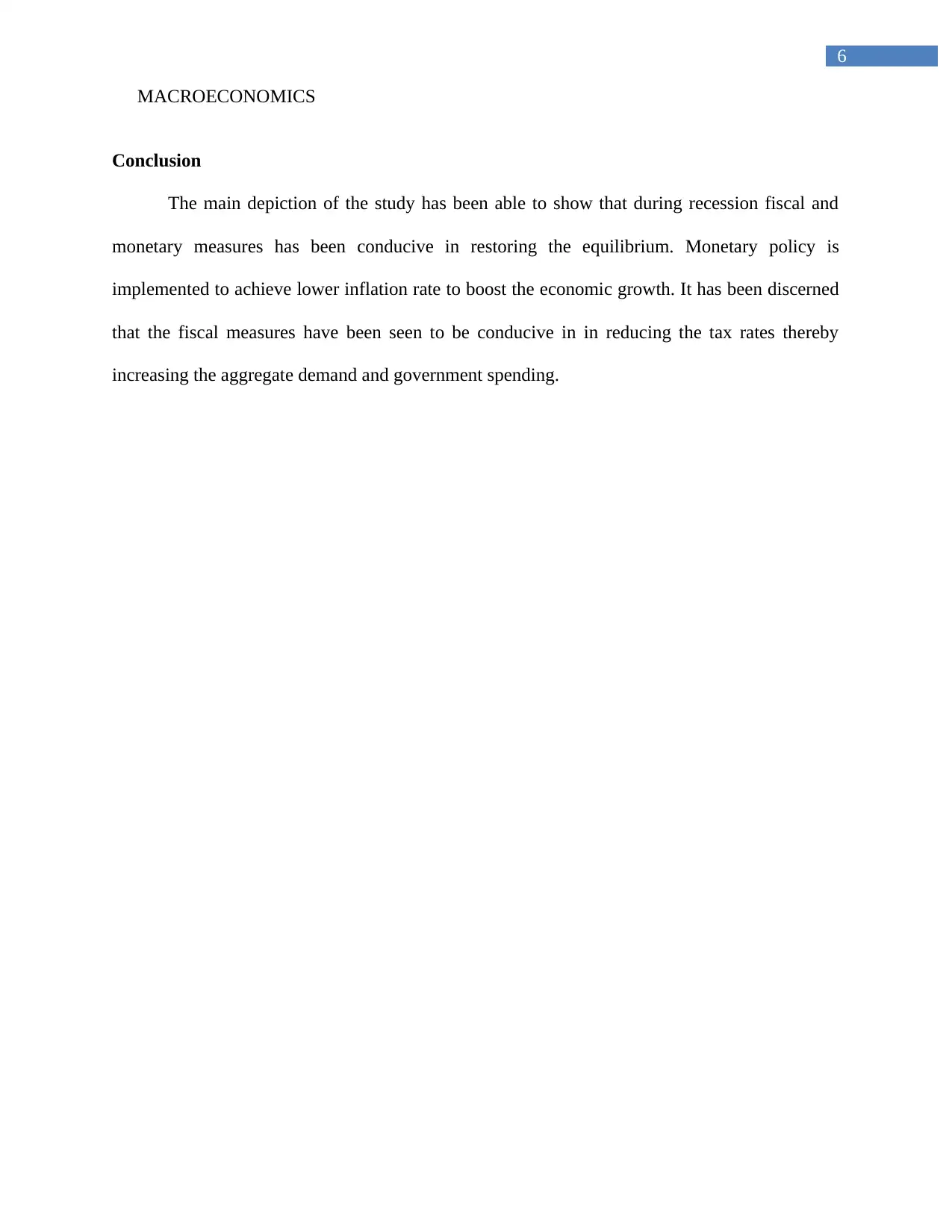
6
MACROECONOMICS
Conclusion
The main depiction of the study has been able to show that during recession fiscal and
monetary measures has been conducive in restoring the equilibrium. Monetary policy is
implemented to achieve lower inflation rate to boost the economic growth. It has been discerned
that the fiscal measures have been seen to be conducive in in reducing the tax rates thereby
increasing the aggregate demand and government spending.
MACROECONOMICS
Conclusion
The main depiction of the study has been able to show that during recession fiscal and
monetary measures has been conducive in restoring the equilibrium. Monetary policy is
implemented to achieve lower inflation rate to boost the economic growth. It has been discerned
that the fiscal measures have been seen to be conducive in in reducing the tax rates thereby
increasing the aggregate demand and government spending.
Paraphrase This Document
Need a fresh take? Get an instant paraphrase of this document with our AI Paraphraser
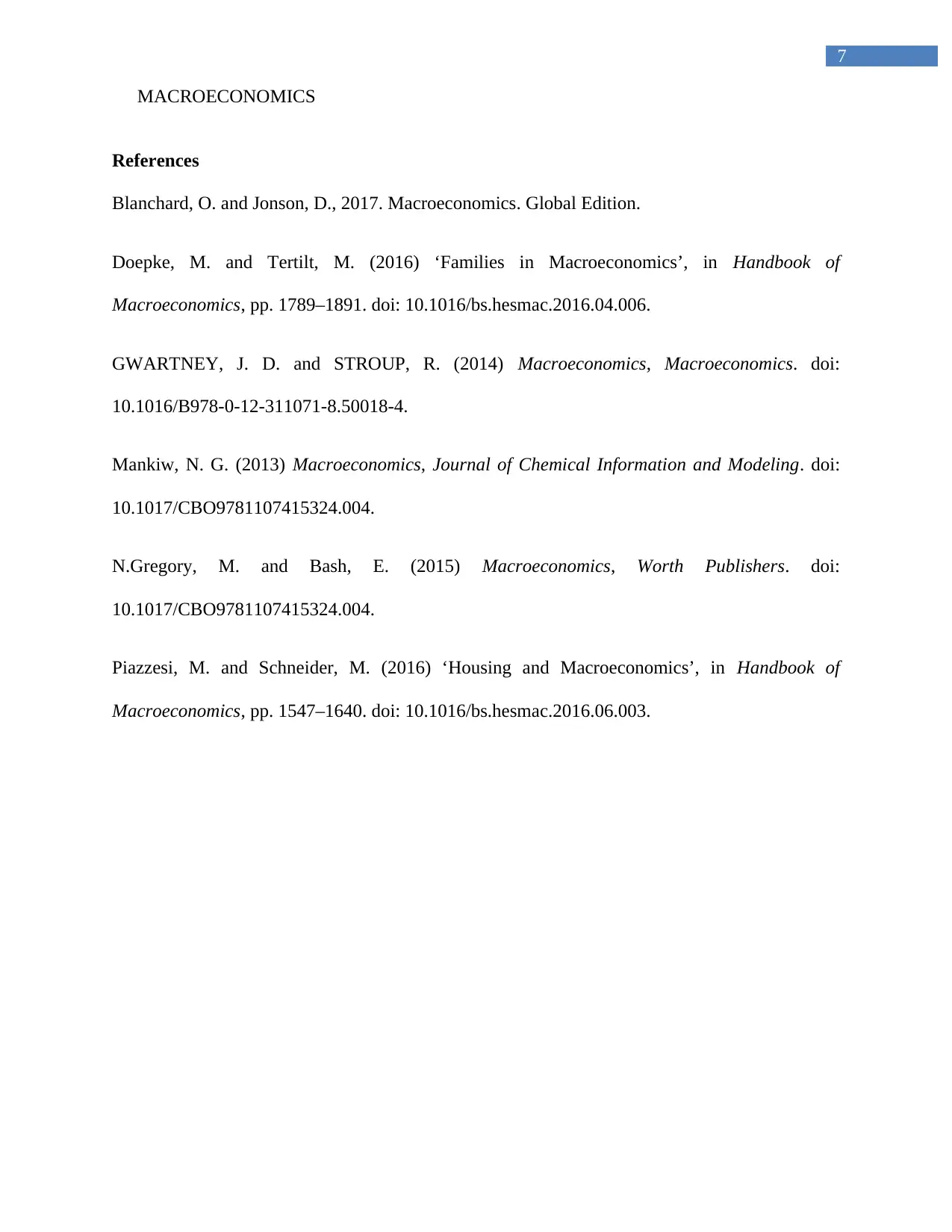
7
MACROECONOMICS
References
Blanchard, O. and Jonson, D., 2017. Macroeconomics. Global Edition.
Doepke, M. and Tertilt, M. (2016) ‘Families in Macroeconomics’, in Handbook of
Macroeconomics, pp. 1789–1891. doi: 10.1016/bs.hesmac.2016.04.006.
GWARTNEY, J. D. and STROUP, R. (2014) Macroeconomics, Macroeconomics. doi:
10.1016/B978-0-12-311071-8.50018-4.
Mankiw, N. G. (2013) Macroeconomics, Journal of Chemical Information and Modeling. doi:
10.1017/CBO9781107415324.004.
N.Gregory, M. and Bash, E. (2015) Macroeconomics, Worth Publishers. doi:
10.1017/CBO9781107415324.004.
Piazzesi, M. and Schneider, M. (2016) ‘Housing and Macroeconomics’, in Handbook of
Macroeconomics, pp. 1547–1640. doi: 10.1016/bs.hesmac.2016.06.003.
MACROECONOMICS
References
Blanchard, O. and Jonson, D., 2017. Macroeconomics. Global Edition.
Doepke, M. and Tertilt, M. (2016) ‘Families in Macroeconomics’, in Handbook of
Macroeconomics, pp. 1789–1891. doi: 10.1016/bs.hesmac.2016.04.006.
GWARTNEY, J. D. and STROUP, R. (2014) Macroeconomics, Macroeconomics. doi:
10.1016/B978-0-12-311071-8.50018-4.
Mankiw, N. G. (2013) Macroeconomics, Journal of Chemical Information and Modeling. doi:
10.1017/CBO9781107415324.004.
N.Gregory, M. and Bash, E. (2015) Macroeconomics, Worth Publishers. doi:
10.1017/CBO9781107415324.004.
Piazzesi, M. and Schneider, M. (2016) ‘Housing and Macroeconomics’, in Handbook of
Macroeconomics, pp. 1547–1640. doi: 10.1016/bs.hesmac.2016.06.003.
1 out of 8
Related Documents
Your All-in-One AI-Powered Toolkit for Academic Success.
+13062052269
info@desklib.com
Available 24*7 on WhatsApp / Email
![[object Object]](/_next/static/media/star-bottom.7253800d.svg)
Unlock your academic potential
Copyright © 2020–2025 A2Z Services. All Rights Reserved. Developed and managed by ZUCOL.





